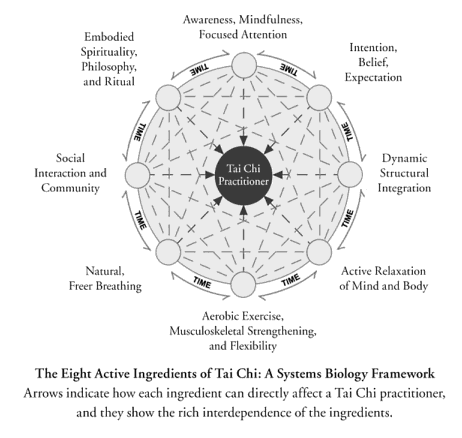The Harvard Medical School Guide to Tai Chi by Peter Wayne (2013) outlines eight active ingredients of TCC. These are summarized here:
1) Breathing: “Qi” is often translated simply as “breath.” In TCC it should be slow, regular, steady, and directed to the belly/lower dan tien. Some of the many health effects of simply breathing properly are: increased oxygen exchange, emotional regulation/calming via the autonomic nervous system (dampened sympathetic and enhanced parasympathetic response), an increased awareness of the inter-relationship between outer and inner/self and environment, internal organ “massage” via pressure changes from the contraction/relaxation of the diaphragm, enhanced flexibility of the ribcage and thoracic spine, and a mental quieting/meditative state from increased focus on the dynamics of the breath, encouraging the experience and enjoyment of “present moment consciousness.” The breath should be simply observed, without attempts to change the pattern or speed. Attention to the suspended, upright head posture improves the quality and depth of the breath.
2) Active Relaxation: The modern ethos in modern Western culture is “give it your all” and “push the envelope.” TCC counsels us to seek balance and avoid extremes of “doing” (yang) and non-doing (yin). All creation is a continuum of forces, not an opposition. This characterizes the idea of “song” or loosened/unbound. The joints of the body are always “song”– the “gates” are open but never collapsed. This respects individual physical limitations and lessens kinesiophobia or nervous guarding by never exceeding the body’s ability to embrace change out of pain or apprehension. The body is like a buoy floating on water.
3) Awareness: Focused attention or awareness is “ting.” It must be constant and ever-present during practice. It is “ting” that transforms the breath, slow movements, body positions and transitions of TCC into a movement meditation and “present moment consciousness.”
4) Intention: The directed focus of intention (yi) through mental imaging and visualization, commitment, and passion enhances the manifestation of internal energy.
5) Strength/Flexibility: TCC has been called (like yoga) a “metarobic” exercise. It compares to moderately-paced walking (3 mph) in its aerobicity. Unlike traditional aerobic exercise, however, the increased blood flow and oxygen exchange is appreciated in all body tissues, including the internal organs, not just the musculoskeletal system. TCC enhances muscular leg strength, dynamic tissue stretching, core stabilization, joint opening, and more efficient and coordinated whole body movement.
6) Structural Integration: TCC’s emphasis on the body as a unified energy field rather than a mechanical conglomeration of various “parts,” on vertical postural alignment and the elongation/expansion of all joints, on movement from the center of gravity (lower dan tien), on the consistency of the pace of movement and constancy of attention to the dynamics of physical postural changes and weight transfers, is the foundation of the integration of the psych-physical structure of the body.
7) Networking: The social and communal nature of a TCC practice in classes, parks, etc. and the regular exchange of concepts and skills common in these settings as well as during two-person “push hands” practice and drills, contribute a valuable psycho-social and anti-isolation component to the benefits of TCC.
8) Spirituality: All of the above factors are inherent in the unification of mind/body/spirit that is the essential nature and lesson of TCC: the fostering of mental and physical “balance,” the appreciation of the constancy of change, the adaptability and resilience from the non-opposition practices of yielding and redirecting energy forces, the enhancement of cellular health/homeostasis, the emphasis on individual responsibility and self-cultivation leading to a sense of self-efficacy and confidence as a pro-active participant in personal health through more conscious lifestyle choices, the effect of the meditative and ritualistic aspects of TCC on psychoneuroimmunology, all of which may ultimately lead to an examination of the question “What IS the self?” or Self-realization.

